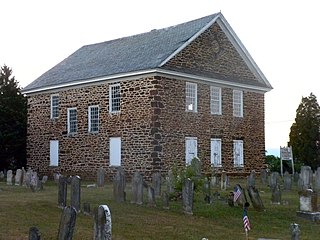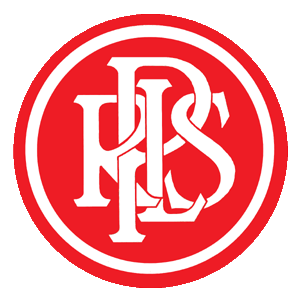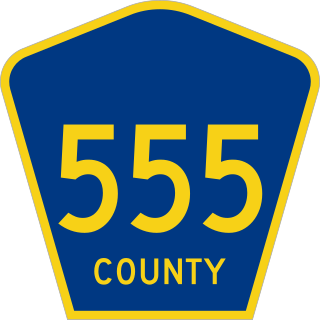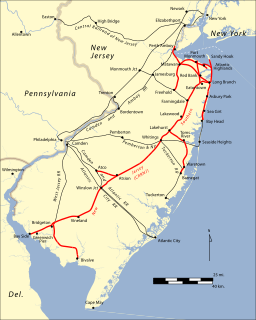Related Research Articles

Route 49 is a state highway in the southern part of the U.S. state of New Jersey. It runs 53.80 mi (86.58 km) from an interchange with the New Jersey Turnpike, Interstate 295 (I-295), and U.S. Route 40 (US 40) in Deepwater, Salem County, southeast to Route 50 and County Route 557 in Tuckahoe, Cape May County. The route serves Salem, Cumberland, Atlantic, and Cape May Counties, passing through rural areas and the communities of Salem, Bridgeton, and Millville along the way. It is a two-lane, undivided road for most of its length.

Lawrence Township is a township in Cumberland County, New Jersey, United States. It is part of the Vineland-Millville-Bridgeton Primary Metropolitan Statistical Area for statistical purposes. As of the 2010 United States Census, the township's population was 3,290, reflecting an increase of 569 (+20.9%) from the 2,721 counted in the 2000 Census, which had in turn increased by 288 (+11.8%) from the 2,433 counted in the 1990 Census.

Route 162 is an unsigned 0.70-mile (1.13 km) long state highway in Lower Township, New Jersey, United States. The highway's designation consists entirely of a bridge on Seashore Road, which is known as Relocated Seashore Road. The southern terminus of the highway is an intersection with County Routes 641 and 626 in Lower Township. After crossing the Cape May Canal, Route 162 terminates at an intersection with County Routes 603 and 626 in Lower Township. Route 162 and County Route 626 date back to the 1850s, when local businessmen and county financial Richard Holmes put together the Cape May Turnpike. The turnpike was chartered in 1854, but construction did not begin until 1857, with completion in April of the next year. The turnpike however, caused a lot of controversy, and struggled to live. For many years, railroads were proposed, becoming possible competition for Holmes, who did not appreciate the idea. The railroad was constructed in 1863, just nine years after the charter of the turnpike syndicate.

The Pennsylvania-Reading Seashore Lines was a railroad that operated in southern New Jersey in the 20th century. It was created in 1933 as a joint consolidation venture between two competing railroads in the region.
Conrail Shared Assets Operations (CSAO) is the commonly used name for modern-day Conrail, an American railroad company. It operates three networks—the North Jersey, South Jersey/Philadelphia, and Detroit Shared Assets Areas, where it serves as a contract local carrier and switching company for its owners, CSX Transportation and the Norfolk Southern Railway. When most of the former Conrail's track was split between these two railroads, the three shared assets areas were kept separate to avoid giving one railroad an advantage in those areas. The company operates using its own employees and infrastructure, but owns no equipment outside MOW equipment.
The Millville Traction Company operated streetcars in Millville, New Jersey, and along an interurban streetcar line to Vineland, New Jersey, along Main Road and Landis Avenue.

Streetcars in Washington, D.C. transported people across the city and region from 1862 until 1962.

County Route 555 is a county highway in the U.S. state of New Jersey. The highway extends 34.20 miles (55.04 km) from Port Norris Road in Downe Township to Black Horse Pike in Washington Township in Gloucester County.

County Route 553 is a county highway in the U.S. state of New Jersey. The highway extends 51.22 miles (82.43 km) from Hands Landing Road/Ogden Avenue in Commercial Township to Broadway in Deptford Township.

Pittsburgh Railways was one of the predecessors of the Port Authority of Allegheny County. It had 666 PCC cars, the third largest fleet in North America. It had 68 streetcar routes, of which only three are used by the Port Authority as light rail routes. With the Port Authority's Transit Development Plan, many route names will be changed to its original, such as the 41D Brookline becoming the 39 Brookline. Many of the streetcar routes have been remembered in the route names of many Port Authority buses.

The Pittsburgh Light Rail is a 26.2-mile (42.2 km) light rail system in Pittsburgh, Pennsylvania, and surrounding suburbs. It operates as a deep-level subway in Downtown Pittsburgh, but runs mostly at-grade in the suburbs south of the city. The system is largely linear in a north-south direction, with one terminus just north of Pittsburgh's central business district and two termini in the South Hills. The system is owned and operated by Pittsburgh Regional Transit. It is the successor system to the streetcar network formerly operated by Pittsburgh Railways, the oldest portions of which date to 1903. The Pittsburgh light rail lines are vestigial from the city's streetcar days, and is one of only three light rail systems in the United States that continues to use the Pennsylvania Trolley (broad) gauge rail on its lines instead of 4 ft 8+1⁄2 instandard gauge. Pittsburgh is one of the few North American cities that have continued to operate light rail systems in an uninterrupted evolution from the first-generation streetcar era, along with Boston, Cleveland, New Orleans, Newark, Philadelphia, San Francisco and Toronto. In 2021, the system had a ridership of 27,975,600.

The International Railway Company (IRC) was a transportation company formed in a 1902 merger between several Buffalo-area interurban and street railways. The city railways that merged were the West Side Street Railway, the Crosstown Street Railway and the Buffalo Traction Company. The suburban railroads that merged included the Buffalo & Niagara Electric Street Railway, and its subsidiary the Buffalo, Lockport & Olcott Beach Railway; the Buffalo, Depew & Lancaster Railway; and the Niagara Falls Park & River Railway. Later the IRC acquired the Niagara Gorge Railroad (NGRR) as a subsidiary, which was sold in 1924 to the Niagara Falls Power Company. The NGRR also leased the Lewiston & Youngstown Frontier Railroad.

Streetcars and interurbans operated in the Maryland suburbs of Washington, D.C., between 1890 and 1962. Lines in Maryland were established as separate legal entities, but eventually they were all owned or leased by DC Transit. Unlike the Virginia lines, the Washington and Maryland lines were scheduled as a single system. Most of the streetcar lines were built with grand plans in mind, but none succeeded financially. A combination of the rise of the automobile, various economic downturns and bustitution eventually spelled the end of streetcars in southern Maryland.
The Capital Traction Company was the smaller of the two major street railway companies in Washington, D.C., in the early 20th century. It was formed in 1895 through a merger of the Rock Creek Railway and the Washington and Georgetown Railroad Company. The company's streetcars connected the Washington, D.C., neighborhoods of Georgetown, Capitol Hill, the Armory, and Mount Pleasant; and the suburb of Chevy Chase, Maryland. In 1933, it merged with its major competitor, the Washington Railway and Electric Company, to form the Capital Transit Company.

The New Jersey Southern Railroad was a railroad that started in 1854. It would continue under this name until the 1870s as a separate company and the lines that it had constructed or run continued to be run in the New Jersey Southern name until the early 2000s.
The News of Cumberland County, previously the Bridgeton Evening News, was a daily newspaper in Cumberland County, New Jersey, United States. It was published from 1879 until 2012, when it merged with two other papers from the South Jersey area, Today's Sunbeam and the Gloucester County Times, to form the South Jersey Times.
The Lawrence Township School District is a community public school district that serves students in pre-kindergarten through eighth grade from Lawrence Township, in Cumberland County, New Jersey, United States.

The West Jersey and Seashore Railroad (WJ&S) was a Pennsylvania Railroad subsidiary in the U.S. state of New Jersey with a connection to Philadelphia. It was formed through the merger of several smaller roads in May 1896. At the end of 1925 it operated 379 miles (610 km) of road on 717 miles (1,154 km) of track; that year it reported 166 million ton-miles of revenue freight and 332 million passenger-miles. The railroad became part of Pennsylvania-Reading Seashore Lines in 1933.
The North Jacksonville Street Railway, Town and Improvement Company was promoted by R. R. Robinson to be built, owned and operated by the black citizens of Jacksonville, Florida, to link the northwestern part of the city with downtown. Organized by several prominent members of Jacksonville's black community, it was known as "The Colored Man's Railroad." The company received a franchise from the City Council on July 1, 1902, to build the line from Bay Street north on Clay to State and out the Kings Road to the city limits along what is now Myrtle Avenue, and returning via Moncrief Road to downtown through Hansontown. In May 1903, the Council granted an addition to the franchise allowing a line east on State to Washington to Jessie, terminating at Talleyrand Avenue in the Oakland neighborhood. The franchise was good for thirty years, with the city having an option to buy. The original line opened on Saturday, August 22, 1903, with hundreds of Jacksonville's black population lining up for a ride on "their" streetcars, operated with black motormen and conductors. The official opening was on August 24, with music and refreshment at Mason's Park and speeches by several dignitaries, including Mayor George M. Nolan and former Mayor Duncan U. Fletcher.
References
- ↑ "National Park Service: Southern New Jersey and the Delaware Bay (Chapter 6)". Archived from the original on 2012-10-24. Retrieved 2011-08-22.